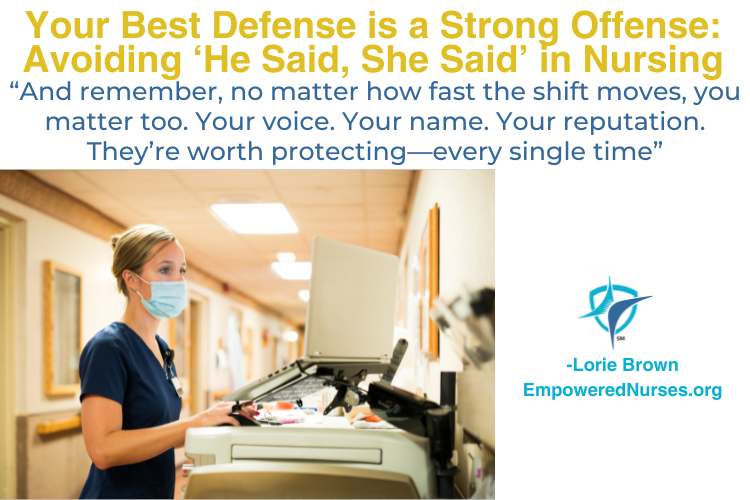Your Best Defense is a Strong Offense: Avoiding ‘He Said, She Said’ in Nursing

It was 2:45 a.m. when it happened. I had just sat down for the first time all night. One of my patients, a sweet elderly man with dementia, had been restless and in pain since midnight. I had given him his scheduled pain medication around 1:30 a.m., documented everything, and even noted his verbal response: “Thank you, honey. That’s better.”
But an hour later, his daughter arrived for a surprise visit. I walked into the room to hear her saying, “You mean they haven’t given you anything for pain?”
The patient, confused and tired, simply nodded.
The daughter was furious. She stormed to the nurses’ station and demanded to speak to the charge nurse. “My dad said no one’s given him any medication all night—what happened to his morphine. Who took it?”
Suddenly, I was under investigation. A missing narcotic. A patient who couldn’t clearly advocate for what had or hadn’t happened. And only my word against theirs.
I thank God every day that I had documented the administration immediately—time given, response observed, and a double-check of the count with the Pyxis.
That note saved me.
That tiny timestamped detail was the only thing that kept a simple misunderstanding from becoming a reportable event.
🖊️ If It’s Not Documented, It Didn’t Happen
We say it all the time—but we forget how true it is until we’re standing in the hallway trying to explain something from memory.
In my case, having accurate documentation of the med, the response, and the count saved me from a nightmare. It reminded me that our charting is our shield.
Even when we’re exhausted, behind, or overwhelmed—documentation must come first. It’s not just about protecting ourselves—it’s about protecting our patients, our license, and the truth.
🗣️ Say It, Repeat It, Document It
Every interaction—especially those involving meds, verbal orders, or patient complaints—needs clarity and confirmation.
Repeat the order back. Clarify what the patient wants. If someone questions your care, document that too. “Patient expressed concern that pain medication was ineffective” is a legitimate entry.
You’re not just covering yourself—you’re building a clear, consistent trail of communication that can speak on your behalf if needed.
👀 Keep Your Notes Objective and Professional
What saved me wasn’t just that I charted. It was how I charted. No vague terms. No “seems like.” I included the direct quote from the patient and the specific time of administration.
Let your chart reflect what you saw and heard—not what you think or assume. That’s the difference between a defensible note and a questionable one.
🙋♀️ Don’t Be Afraid to Escalate
If something doesn’t sit right—say something. If a family member is accusing you, bring in your charge nurse. If a provider’s order feels off, clarify it. Trust your instincts.
And always, always write an incident report if you think the situation might come back around later. It’s not tattling—it’s protecting.
🤝 Watch Out for Each Other
Nursing isn’t a solo sport. If you’re administering a narcotic, ask a coworker to verify it with you. If you’re having a difficult conversation with a family, invite your charge nurse to be present.
One witness can make all the difference.
💬 Final Thoughts: This Could Happen to Any of Us
That night, I didn’t do anything wrong. But if I hadn’t documented the med when I gave it—if I hadn’t written that the patient verbally responded—it could’ve been a very different story.
We all became nurses to help people. But part of helping is protecting the care we give with clear, consistent communication.
So to my fellow nurses: Chart like your license depends on it—because sometimes, it does.
And remember, no matter how fast the shift moves, you matter too. Your voice. Your name. Your reputation. They’re worth protecting—every single time.


